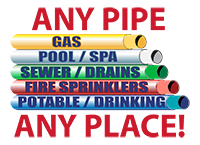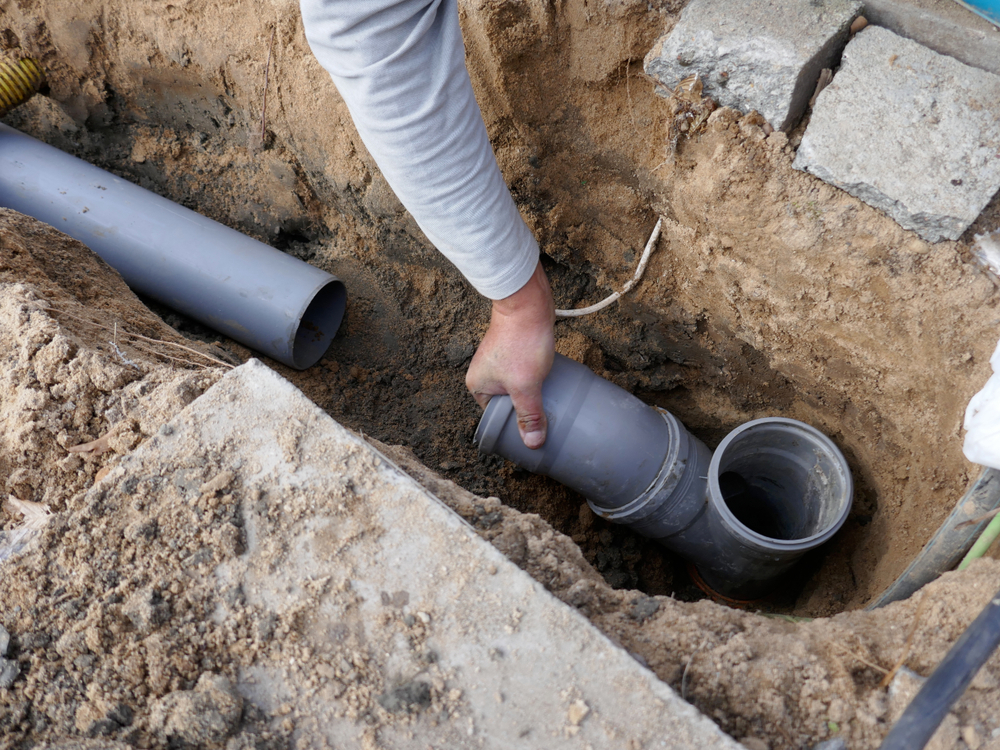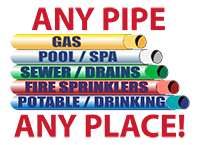Whether it’s clogs, backups, or leaks, sewer problems are a real hassle and can disrupt your daily life. However, when it’s time to fix those broken pipes, people often get stuck between two options: trenchless sewer line repair vs. traditional repair. Which one is the right choice? Which method can help you quickly get rid of the foul smell and potential health hazards that a malfunctioning sewer system brings along?
To make an informed choice, you must evaluate the good and the not-so-good things about both trenchless and traditional sewer repair methods. Also, you must evaluate your individual situation, time, budget, and goals. After all, with San Diego’s emphasis on sustainability and minimal disruption, choosing the most appropriate sewer repair method is extremely essential.
In this article, we will take you into the not-so-exciting world of sewer line repairs, exploring the advantages and disadvantages of both trenchless and traditional approaches. We’ll equip you with the insights needed to make an informed decision about the best method for your specific sewer repair needs.
Traditional Sewer Line Repair: Evaluating the “Time-Tested” Sewer Repair Methodology
Traditional sewer line repair, often referred to as “open-cut” or “dig and replace” repair, has been the standard for decades. A go-to method for thousands of people, the traditional approach involves:
- Excavating the damaged area: The process begins with digging a trench or excavation around the damaged section of the sewer line. This exposes the affected area and provides access for repair.
- Removal of the Damaged Section: Once the damaged portion is exposed, it is carefully removed from the sewer line. This step ensures that the problematic segment is entirely replaced.
- Replacement: A new section of sewer pipe, typically made of durable materials such as PVC or cast iron, is installed in place of the removed segment. This replacement pipe is then securely connected to the existing sewer line.
- Restoration of the Excavated Area: After the replacement is complete, the excavated area is backfilled with soil. Any disrupted landscaping, pavement, or structures are restored as closely as possible to their original condition.
The Advantages of Traditional Sewer Line Repair
Traditional sewer line repair is a conventional approach and offers several benefits that have contributed to its enduring popularity:
- Versatility: Whether you are dealing with small cracks or significant damage, the “dig and replace” method is well-suited for a range of sewer line issues. Its seamless adaptability allows it to address a variety of scenarios and meet the diverse needs of homeowners.
- Familiarity: This method is widely known and understood by plumbing professionals, and skilled technicians are readily available to carry out the repairs.
- Predictable Cost Structure: In traditional repair methods, the cost of sewer line repair can be accurately estimated, and homeowners can get a clearer understanding of the financial commitment involved.
The Disadvantages of Traditional Sewer Line Repair
Despite the aforementioned advantages, there are numerous considerations to keep in mind when opting for traditional sewer line repair. These include:
- Significant Damage to Property: One of the biggest drawbacks of traditional sewer repair is the extensive excavation required. Digging trenches can lead to substantial disruption to your property, including damage to landscapes, driveways, and structures. The need for restoration work after the repair can further add to the inconvenience and cost.
- Extended Timeline: When comparing trenchless sewer line repair vs. traditional repair, it is worth noting that traditional repair often requires a longer timeline. After all, the process of excavation, repair, and restoration takes time, so you must stay prepared for a non-functional sewer system for an extended period.
- Extremely labor-intensive: Traditional sewer repair involves manual labor, including digging and heavy lifting. This labor-intensive nature can contribute to higher costs and potential delays if unforeseen challenges arise.
- Higher Costs Over Time: Estimating the cost of repair is extremely important, to avoid hefty surprises later. While the upfront costs of traditional repair may seem lower, the expenses associated with excavation, restoration, and potential future repairs can quickly add up. This can make the traditional repair less cost-effective in the long run, especially when compared to trenchless sewer line repair, which involves less disruption and better longevity.
- Limited Accessibility: In some cases, the damaged sewer line may not be easily accessible due to its potential location. In such cases, a traditional repair can become significantly more complicated and costly and may require extensive digging and disruption to the property.
- Environmental Impact: The excavation process has a potential environmental impact too. It disturbs the soil, disrupts vegetation, and potentially affects local ecosystems. This aspect might not align with the environmentally-conscious practices of San Diego.
- Inconvenience to Homeowners: The disruption caused by excavation and the subsequent restoration can be a significant inconvenience to homeowners. This is especially true if the repair work disrupts daily routines and limits your access to certain sections or areas of your property.
- Potential for Future Issues: Traditional repair may fix the immediate problem, but it doesn’t address underlying issues that could lead to future sewer line problems. For instance, if tree roots were the cause of the damage, they could grow back and damage the repaired section again.
- Lack of Technological Advancements: Traditional repair methods still rely on age-old repair technologies and may not offer the same level of precision and efficiency that newer methods offer.
Trenchless Sewer Line Repair: Unveiling the Innovation
Trenchless sewer line repair is a relatively modern technique for sewer line repair. It has gained immense popularity in recent years due to its efficiency and reduced impact on the surrounding environment.
Using cutting-edge technology, trenchless methods offer an alternative to the traditional “dig and replace” approach. It uses existing access points, such as manholes or cleanouts, to conduct repairs and minimizes the need for extensive excavation. This way, it reduces disruption to landscapes and structures – something that’s extremely common in traditional repair.
This innovative methodology employs a range of techniques that drastically minimize the need for disruptive excavation. These include:
- Pipe Relining (Cured-in-Place Pipe, or CIPP): This technique involves inserting a flexible lining coated with a resin compound into the damaged pipe. Once positioned, the lining is cured to form a robust, seamless, and long-lasting new pipe within the existing one. Notably, this process requires only limited access points and thus minimizes the need for extensive digging.
- Pipe Bursting: A more aggressive approach, pipe bursting involves pulling a new pipe through the existing one while simultaneously fracturing the old pipe. This method effectively replaces the damaged pipe with a new one while drastically reducing the scale of excavation.
The Many Advantages of Trenchless Sewer Line Repair
While immediate repair is the most potential advantage of trenchless sewer repair, its merits extend way beyond this. Some of the other benefits of choosing trenchless sewer repair over traditional repair include:
- Minimal Disruption: In the tug-of-war of trenchless sewer line repair vs. traditional repair, trenchless methods win hands down as they require minimal excavation or digging. This means there is minimal damage to the property, driveways, and structures. This is particularly advantageous for San Diego homeowners who value their outdoor spaces.
- Faster Repairs: Trenchless repairs follow a streamlined process. It’s a quick, non-invasive method of repairing or rehabilitating damaged pipes that’s both effective and time-saving. Plumbers can complete their job quickly and effectively, without causing any inconvenience for homeowners or neighbors.
- Cost-Effective: While the initial costs of trenchless repairs may be slightly higher than traditional methods, they are most cost-effective in the long run. With reduced excavation, seamless restoration, and affordable labor costs, residential and commercial owners can save a lot of their hard-earned money.
- Durability: The piping material used during trenchless repair is extremely durable and long-lasting. It can withstand a range of temperatures, pressure, and sewage chemicals. This, in turn, can extend the lifespan of the repaired sewer line.
- Environmentally Friendly: Trenchless repair is an environmentally friendly practice as it significantly reduces the need for excavation. This translates to fewer disturbances to the natural environment – something that aligns well with San Diego’s commitment to sustainability.
Trenchless Sewer Line Repair Vs. Traditional Repair: Which Repair Option is Right for You?
When it comes to addressing and resolving sewer line issues, the choice between trenchless sewer line repair and traditional repair is tough. It can leave homeowners confused and looking for expert help.
However, selecting the right approach depends on various factors that may be unique to your situation. So carefully evaluate each of them and make an informed decision.
Severity of Damage
The extent of damage to your sewer line plays a crucial role in determining the most suitable repair option. For minor cracks or issues, a traditional repair might suffice. But, if the damage is extensive or requires extensive excavation, trenchless repair could provide a more efficient and effective solution. Consulting with professionals to assess the severity of the damage will guide you toward the appropriate choice.
Budget
While trenchless repairs may come with a higher initial cost, it’s essential to look beyond the immediate expense. Consider the long-term savings that trenchless methods offer. Trenchless repairs need less excavation and restoration and can prove to be a financially prudent choice over time. Compare the upfront investment with the potential long-term benefits to make an informed budgetary decision.
Environmental Impact
When conducting sewer repair, it is important to consider the impact it will have on your surroundings. Trenchless methods are non-invasive techniques that require minimal disruption to the natural surroundings. By opting for trenchless repair, you contribute to the preservation of San Diego’s ecosystem and minimize the footprint of the repair process.
Timeline
The urgency of your sewer line repairs and your timeline expectations must also play a role in your decision-making process. Trenchless methods offer a quicker turnaround as compared to traditional sewer repair methods, which involve more extensive excavation and restoration. So, if you are short on time, then trenchless repair would be a more suitable option for you.
Convenience and Disruption
The disruption caused by excavation is a significant consideration. Trenchless methods are designed to minimize disruption to your property, keeping your yard, driveway, and landscape largely intact. If you value convenience and wish to avoid extensive restoration work after the repair, trenchless methods offer a clear advantage. It will help you save time, money. and the inconvenience that traditional sewer repair methods bring along.
Making the Right Choice
Ultimately, the choice between trenchless and traditional sewer line repair comes down to a comprehensive evaluation of your specific needs, priorities, and circumstances. Each factor mentioned above contributes to the decision-making process, and striking the right balance among them is key.
Consulting a professional plumbing company that specializes in both trenchless and traditional methods can provide invaluable insights. Their team can assess your sewer line’s condition, understand your preferences, and help you evaluate the pros and cons of each method. Armed with this information, you can confidently make a choice that aligns with your goals, budget, and timeline while contributing to San Diego’s commitment to sustainable practices.
Remember, the goal is to ensure a smoothly functioning sewer line that meets your needs while minimizing disruption and impact. So, carefully consider the advantages, disadvantages, and specific needs of your situation. This will help you make a confident choice that seamlessly restores your malfunctioning sewer system.
If you are looking for expert assistance, don’t hesitate to reach out to our team of skilled plumbers.
At San Diego Plumbing and Pipe Lining Company, we offer a comprehensive range of pipeline services for both residential and commercial properties. Whether it’s the installation, repair, or maintenance of pipeline systems, we’ve got you covered.
From tackling pesky leaky faucets and stubborn clogged drains to advanced pipe lining solutions, our dedicated team is equipped to handle it all. With our extensive expertise and in-depth knowledge of modern plumbing systems, we’re here to guide you in making the right choices for your needs.
Get in touch with us today to experience the difference that our reliable and expert service can make.







